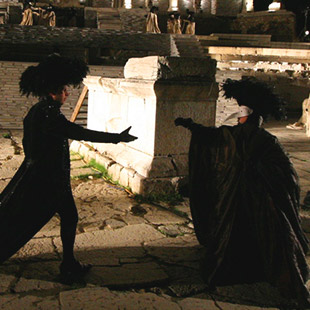The 9 Mozart Pieces Every Piano Player Needs to Know
Mozart remains one of the best-known composers of all time, and with good reason. Here are 9 of his most well-loved pieces to learn on piano.
Last updated on 28 Feb. 2024
Wolfgang Amadeus Mozart: you probably know this name, even if you've never knowingly listened to his music. A child prodigy, he started writing his own music at age 5 and composed over 600 gorgeous works before dying in 1791, at age 35. This includes a heartbreaking requiem that Mozart reportedly—and sadly, somewhat accurately—believed he was writing for himself (you'll find it in this list).
There are so many tales about this legendary Classical-era composer, it's difficult to pin down the facts, but his music tells truths too, echoing his optimism, nonconformity, and brilliance. Experience this for yourself by playing some of his most well-loved and lasting compositions. We've gathered 9 of them below.
All of these are available to learn with flowkey—and in various levels, from Beginner to Pro.
1. Rondo alla turca – Sonata No. 11, K. 331
Mozart's playful, boundary-pushing brilliance at its finest
This lively, playful piece remains one of Mozart's most well known, inspired by Turkish Janissary music that was popular during the time. "Rondo" refers to the piece's structure, in which "episodes" alternate and contrast with a recurring main theme. But Mozart was always pushing boundaries, so it may come as no surprise that this isn't a typical rondo!
The song is fun to play whether you're a beginner or pro, with opportunities to refine your 2-handed playing and rhythm-keeping. We've created 2 arrangements of it—the Intermediate one lets you slow things down before jumping atop the gorgeous, galloping racehorse that is the full, Pro, arrangement.
2. "Non più andrai," Le Nozze di Figaro, KV. 492
A joyful, bouncing trip across the keys
Mozart was known as much for his operas as for his piano music, and The Marriage of Figaro remains one of the most popular operas even now. This grand aria, "Non più andrai," or "You Shall Go No More," has a playful, bouncing melody that characterizes classical opera, but sounds equally memorable as a theme played on the piano, earning its place in many piano students' repertoires.
flowkey's Beginner- and Intermediate-level arrangements for this piece offer a wonderful opportunity for practicing hand independence, or playing different notes and rhythms with each hand. It's also short, sweet, and incredibly fun to play—sure to add some joy to your practice sessions.
3. Eine kleine Nachtmusik
A Mozart song you definitely know, even if you didn't know it's by Mozart
The literal translation of this piece is "A Little Night Music," but we can more accurately understand it as Mozart's unique way of saying "a little serenade." He merely noted in his records that he'd written "eine kleine Nachtmusik," and when the piece was published after his death, the phrase stuck.
This is one of the most frequently performed and well-known Classical pieces—not just of Mozart's, but of all time. And it's for good reason: Mozart's sparkling optimism and ingenuity pulse through all 4 movements of the piece—starting with a famous allegro that's become a filmmaker favorite. It's a song to lose yourself in, with a strong gravitational pull. If you play it at a party, prepare to become the center of attention.
4. Don Giovanni: Overture
The moving opening to one of the greatest operas of all time
Considered one of the greatest operas of all time, Don Giovanni is Mozart's interpretation of the legend of Don Juan—a Spanish playboy whose romantic escapades cause his downfall. Mozart captures all of this in his overture, presenting the full range of emotions to come, from explosive passion to haunting tenderness.
This is a great piece for exploring the connection between emotion and dynamics on the piano. It's available in 3 levels on flowkey, from Intermediate to Pro, so you can start slow and simple and work your way up, or dive right into the full piece with reckless abandon—whatever your heart desires!
5. I. Andante grazioso – Sonata No. 11
A lovely, calm moment at the piano
With the first movement of Sonata No. 11, Mozart once again plays with expectations—starting not with a sonata movement, but with variation. What you get is 6 variations on the delicate, pretty main theme.
If you've thought of writing your own music, or even just like the idea of improvising on songs you already know, this movement offers a wonderful opportunity to learn—and from Mozart, no less! It's also a very peaceful song to play, in case you're looking to enjoy a calm moment at the piano.
6. I. Allegro – Sonata No. 16 in C, K. 545
An earworm perfect for strengthening hand coordination
This is another Mozart mainstay that wasn't published until many years after he was gone, but it's far from forgotten. The allegro movement has an absolute earworm of a melody that sticks in the mind for days—or even years, if its popularity is any indication.
With its interplay of right-hand melody and left-hand broken chords, this piece is perfect for strengthening your hand coordination. Mozart noted it as being "for beginners," and it has the nicknames "Sonata facile" (easy) and "Sonata semplice" (simple), but it's arguably more suitable for players at an intermediate level or higher.
7. Molto allegro – Symphony No. 40 in Gm
A melancholic masterpiece from a dark time in Mozart's life
Symphony No. 40 is rare among Mozart's works for being only 1 of 2 symphonies he wrote in minor keys. The work reflects not only Mozart's interest in the Sturm und Drang ("Storm and Stress") artistic movement of the time, but also the dark turn his life had taken.
The first movement is played "molto allegro," or "very fast and lively," which brings a strange lightness to the melancholic minor key. This makes it a fantastic piece for exploring the piano's ability to express complex emotions. It also makes it a challenging (but fun) song to play. Our Beginner-level arrangement slows it down, providing a nice opportunity to work up to the impressive Advanced version.
8. Lacrimosa – Requiem KV. 626
The heartbreakingly beautiful song Mozart never finished writing
Lacrimosa means "tearful," which is fitting for such a mournful yet beautiful piece. According to his widow Constanze, the already-ill Mozart was commissioned by a mysterious messenger to write the requiem—a mass for the dead that he came to believe he was composing for himself. That he died while writing it only adds to the mystery.
The entire requiem is moving, but "Lacrimosa" remains a highlight. To play it on piano is a full-body experience, with the vocal harmonies adapted into chords that will test your hand flexibility—and reward your efforts by giving you goose bumps. It's available to learn with flowkey at an Advanced level, however, intermediate players with patience and tenacity might still be able to manage it!
9. Minuet in G, K. 1
Mozart's very first composition
We end where it all began, with the first piece Mozart ever composed. He was 5 years old, the definition of a child prodigy. The youthful exuberance that fills this joyful, simple piece can't help but make us think of boy Mozart—tiny at the keys of a piano—and wonder at the genius he would become.
In between this and "Lacrimosa," over 600 published works are attributed to Mozart—and that’s not counting all of the unfinished ones that never saw the light of day. That's 30 years of composition that changed the face of music forever.
Discover Mozart and Other Legendary Composers
If you want to discover and learn more of Mozart's work, just search for his name in the flowkey app. Or, if you'd like to branch out to other legendary composers from the Baroque, Classical, and Romantic eras, our article on 14 Classical Piano Pieces is a great place to start.
Play the music you love with flowkey
With flowkey you can learn all kinds of songs in different genres and levels. We've even simplified many of them so you can start playing easier versions and work your way up. A split screen shows you the sheet music as it's played by the hands of a professional pianist—making it easy to play along in whatever way best suits you.
Our Wait Mode, Hand Selector, and Loop features support you in learning a song however you want—at your own pace, 1 hand at a time, and in smaller sections. And you can learn the basics and more with our courses. You can try out a few songs and lessons with our free version, and there's a 7-day trial that unlocks many of our Premium songs and courses.
We're grateful to be part of your piano-learning journey, even if it's only with this article! If we can support you further, please reach out to us at [email protected].
Read next
4 Easy Chords to Learn New Piano Songs Quickly
Chords are the building blocks of music: Learn to master them and you'll be able to learn new songs even faster. Here's how.
10 Easy Piano Songs for Beginners
You don't need tons of practice to play piano songs that you love. Here’s our selection of easy-to-play pieces for beginners, plus a few key tips to set you up for success.
10 Slow and Beautiful Piano Songs to Put You in a Calm Mood
We round up some of our favorite piano songs from composers like Mozart, Frédéric Chopin and Amy Beach to help you bring more beauty — and peace — into your life.
Claude Debussy: 10 Essential Piano Pieces
Debussy's dreamy compositions remind us of the moving power of music. Discover a new song to learn with our list of 10 of his best pieces.









